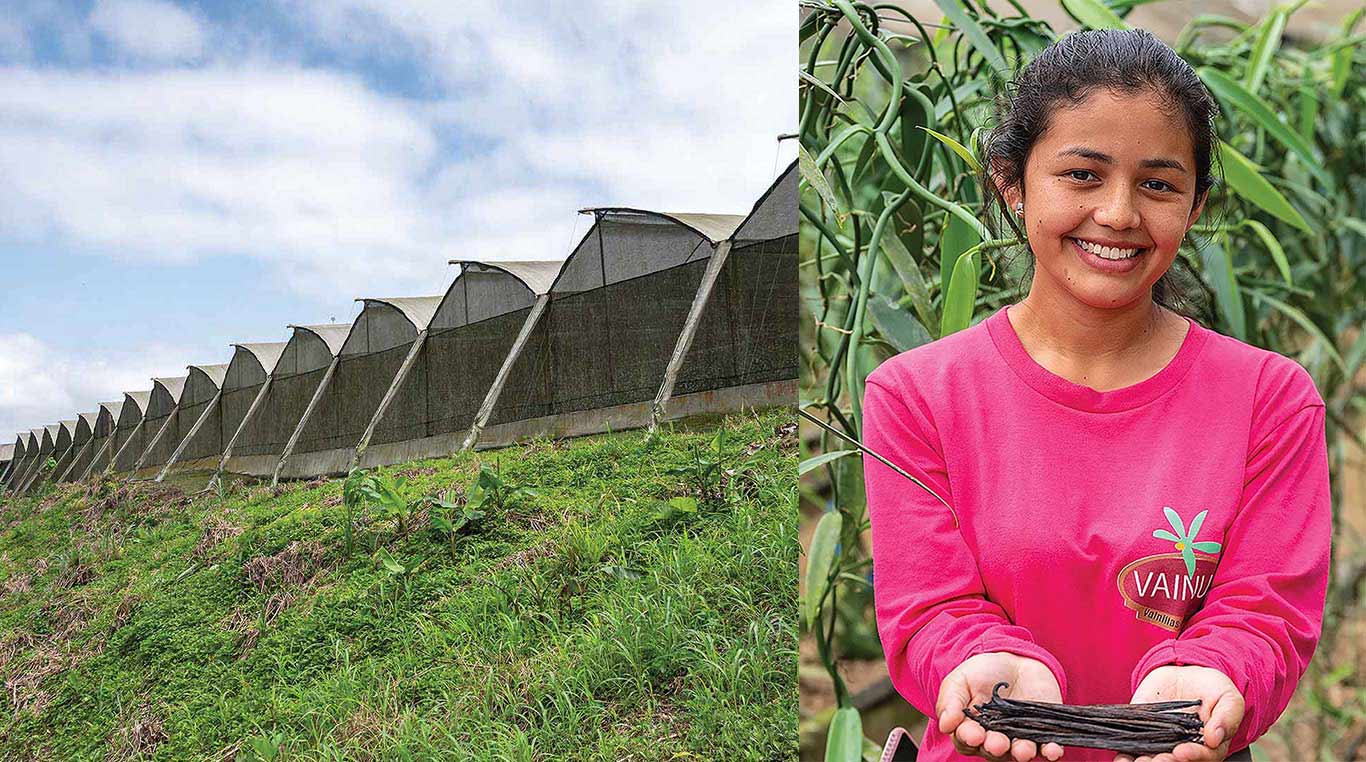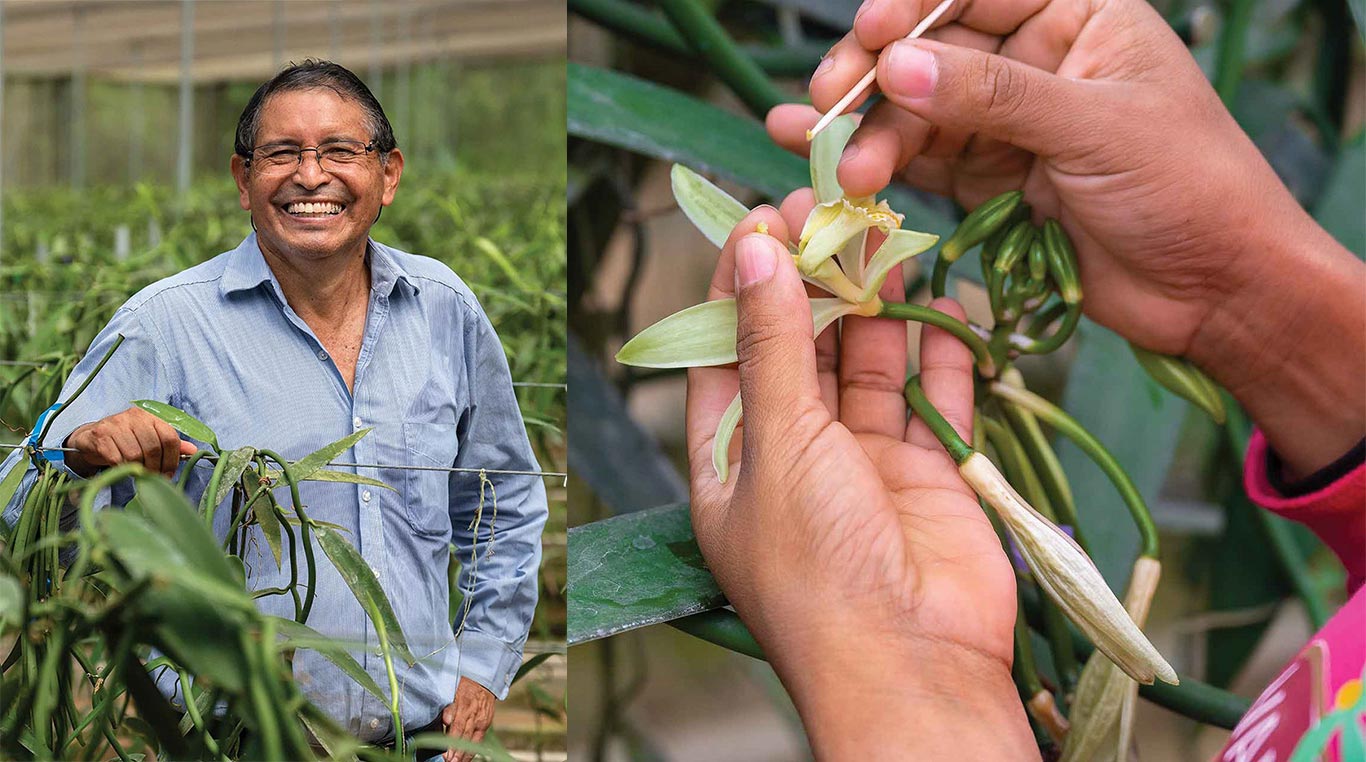Agriculture, Education March 01, 2023
Nothing Vanilla About It
.
"All-natural" food boom cultivates new industry in Ecuador and gives opportunity to young farmers to start their own plantations.
Vanilla is often called the "regular" flavor when nestled next to other cakes, cookies, and ice creams. But when you consider the value of raw vanilla beans rivals that of silver because of how tricky it is to grow, you realize it is anything but "regular."
Food researcher and retired university professor Eduardo Uzcategui, Ph.D., has been captivated by the intricacies of vanilla for more than twenty years and recently developed a high-density growing system that is empowering many underserved women in his community in central Ecuador, one tiny toothpick prick at a time.
The real thing. Vanilla is one of the most widely used spices but is also one of the most expensive so it is often replaced with a synthetic version.
Vanilla beans are the fruit of a climbing orchid plant. In most places around the world, it must be pollinated by hand. The exception is in Mexico where the Melipona bee exists. Each plant produces one flower each season, and that flower is only open for a couple hours. If the fertilization window is missed, no bean cluster will develop. This makes for very tedious farming.
Roughly 80% of the world's vanilla is grown in Madagascar and Indonesia. Mexico follows far behind in third place. In these regions, much of the vanilla is grown by small-holder farmers in plots where the plants climb up other trees.
Increased consumer demand for all-natural foods in recent years has caused major food producers, such as Nestlé, to switch from using inexpensive, synthetic vanillin ingredients (i.e., imitation vanilla) to the difficult-to-grow, natural vanilla. This has consequently driven up the market value for raw vanilla beans to several hundred dollars per kilogram.
According to Uzcategui, the global demand for vanilla is about 11 times the current production level.

Above. Vanilla beans take nine months to mature on the plant. Once harvested they are dried and processed. Julissa Loor has worked in the greenhouses at Vainuz since 2016.
Doing better. "There is an opportunity for vanilla here in Ecuador," Uzcategui says.
Since retiring from serving as the agriculture college dean at the University of San Francisco in Quito, Ecuador, he has put all his efforts into developing vanilla plantations in the Santo Domingo province.
After seven years of trials and growth, his system is reaching his two main goals: bringing more vanilla to the world and creating opportunities for women in the local agricultural industry.
He is as passionate about building opportunity for his community as he is perfecting the science of growing vanilla.
After researching the plant for years, he designed a greenhouse system using a different species than most other commercial vanilla farms that is better suited for Ecuador's climate (Vanilla tahitensis instead of Vanilla planifolia).
The results are impressive.
Proof in the pudding. "We produce 10,000 plants per hectare (2.47 acres) in this system. Our yield is 1,000 kilograms. Mexican farmers only produce 70 kilograms, and farmers in Madagascar produce about 200 kilograms," Uzcategui explains.
His model focuses on the region's college-educated women because the local economy does not otherwise provide a lot of opportunity for the many graduates from the area's agricultural programs.
Greenhouse vanilla production, however, is ideally suited for intelligent, detail-oriented women because of the precision and finesse required. "I built this as a teaching plantation. Women come to work for me, learn how to grow vanilla, and then can build their own farms. I want them to move on," says Uzcategui.
The greenhouse structure is specifically designed so the flowers open and the bean bunches grow at the women's shoulder height so the workers can move quickly and easily from one plant to the next without climbing ladders or bending over for long periods.
"A skilled worker can pollinate a plant in just three seconds in our system," he notes.
We produced about 300 kilograms a year in the beginning," he says. "Our first market was Germany. I sent some samples, and they bought our whole stock. Another early customer asked how many containers (22 tons worth) we could provide. It was clear we needed to quickly increase our production."
In 2022, Uzcategui employed 24 women to manage seven 1,000-square-meter greenhouses. On average, they pollinate 2,000 plants per day, and they still don't have enough vanilla to meet their customers' demands.
In addition to teaching young women to be vanilla farmers and selling the harvested and dried beans, the team has also begun selling plant starts to neighboring farmers and farmers abroad.
According to statistics from the Food and Agriculture Organization of the United Nations (FAO), world vanilla production has doubled in the past 20 years, and market analysts expect this to continue following the plant-based flavoring trends.
"Vanilla can be used for everything," Uzcategui says. ‡

Above. Eduardo Uzcategui, Ph.D., began researching and cultivating vanilla in Ecuador in 2002. Twenty years later, he manages 7 hectares of high-density vanilla greenhouses in Santo Domingo, Ecuador. Each of the approximately 70,000 plants are pollinated by hand once per season by the team of 24 women.
Read More

AGRICULTURE, RURAL LIVING
Gardeners Band Together Despite Their Subdivided World
A suburban Montana garden oasis complete with fig trees makes for a rewarding group endeavor.

SPECIALTY/NICHE
Glass Blown Art
Ottawa Valley artist finds his passion in an age-old art form.

